
It’s definitely important to buy an instrument that you like the look of, but upon closer inspection, you’ll find that the shape of the body effects the tonal properties of the guitar more than you may have previously realized.
Let’s take a look at some of the varieties of acoustic guitar bodies, and why a player may choose an instrument based on its sound as well as its look. We’ll also make note of some famous performers who use each type of acoustic body shape to great effect, so you can get an ear for each type of instrument.
The main types of acoustic guitars are:
- Dreadnought
- Parlor
- Jumbo
- Dreadnought Variants
- Auditorium
- Grand Auditorium
- Classical
We’ll explore each quickly but with enough depth that you’ll come out the other side with all of the info you need to know. We’ll take the list above in order and begin with…
Dreadnought Guitars
Let’s start off with the most common body shape of all, the Dreadnought. C.F. Martin first produced this body shape in 1916 and named it after the HMS Dreadnought, a battleship, due to its larger size and bold sound.
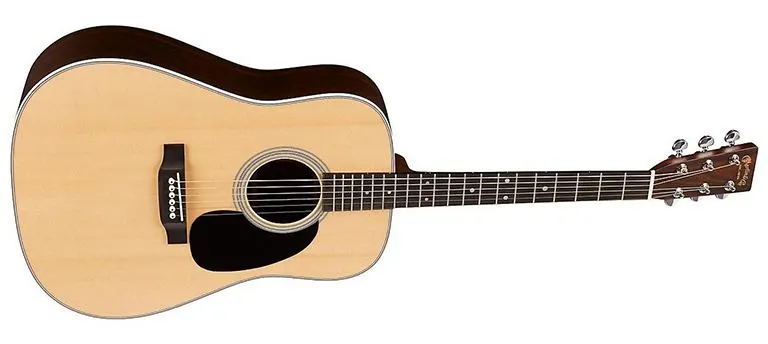
The Dreadnought shape includes very broad square shoulders and a larger internal cavity, which produces a very tight sound that accentuates not only the bass frequencies, but also gives a strong midrange with cutting highs.
These features made the Dreadnought body shape become a preferred tool in the Bluegrass flat picker’s arsenal. The extra volume and tonal range allowed the player to compete with the brash and loud banjo picker, and capable of producing the same highs as the mandolin player.
If you want to hear a great example of the Dreadnought in the Bluegrass setting, look no further than the master himself, Tony Rice.
His accompaniment fits in perfectly with his band, and when its time for him to take the lead, Tony’s picking is loud and crystal clear in all octaves.
Many Folk artists also chose the Martin D series as their go to instrument of choice. A personal favorite of mine would be Joni Mitchell, who effectively used Martin Dreadnoughts to play everything from sweet Folk music, to Jazz, all the way to her unique brand of custom tunings and rhythmic approaches that had never been heard before. All of those sounds emanated from the famous Martin D-35.
For more modern examples, I recommend listening to the Dave Matthews and Tim Reynolds album “Live at Luther College,” where Dave strums his Martin D-28 while Tim Reynolds adds his lead flourishes and accompaniment on his Martin HD-35.
Tim Reynolds also shows how well the Dreadnought can be effects-laden and still provide that “cutting through the mix” lead tone for which the Dreadnought is known. Because of the bold sound of this body shape, the Dreadnought has become a mainstay in the guitar world, and is now offered by every acoustic guitar producer imaginable.
You really can’t go wrong with a Dreadnought, unless you specifically want the sound or vibe of a different body shape. Dreadnoughts are definitely not limited to Bluegrass or Country, and are now widely used in every genre where players prefer a strong, cutting, and bold balanced sound.
Parlor Guitars
Acoustic guitars types with the Parlor shape have gained in popularity in recent years. They are among the smaller bodies, which can be appealing to people with smaller body frames.
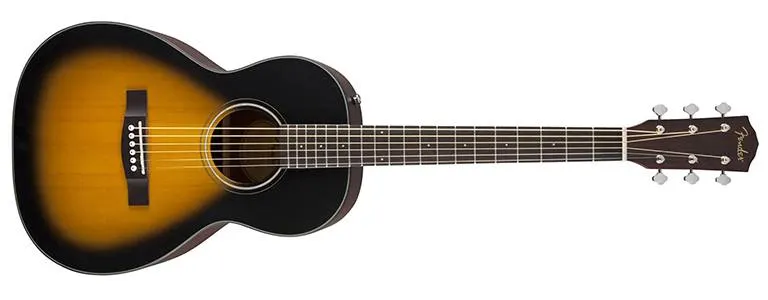
That makes a lot of sense, but they have a certain sound that can be very intimate under certain approaches such as a Folk solo artist who prefers to finger pick alongside soft vocals.
C.F. Martin invented the Parlor body shape in the 19th century and has enjoyed resurgence in recent years due to players who prefer its “throwback” vibe. Many early Blues players, most notably the late great “King of the Delta Blues” Robert Johnson, used his bottle neck slide in conjunction with his Parlor guitar to change the music world.
They were also mass-produced during the era, so Parlor guitars offered a widely available cheap solution for the travelling troubadour (See the Fender pictured above).
Ian Anderson of Jethro Tull employed Parlor guitars for his Irish inflected acoustic work and is a fantastic example of how well the tonal properties of the body shape allows the guitar to fit in with a full band. From full-on strumming to subtle finger picking, Anderson could make the Parlor guitar speak or wail, which shows the full capabilities of the smaller shape.
More recently, John Mayer uses his Martin signature series Parlor guitar for his solo performances. “Something Like Olivia” is a perfect example of the well-balanced tone this acoustic body shape can offer.
The Parlor body shape is an excellent choice for the solo artist because of its light, yet balanced tonal spectrum. They are smaller and easier to travel with as well!
Jumbo Guitars
We’ve seen the standard of acoustic guitars, and we’ve taken a look at one of the most popular smaller shapes. Let’s dive into the big boy of the acoustic guitar world, the Jumbo body shape!
Gibson introduced the Jumbo body shape in 1937 with the release of the J-200 model. This shape is more rounded in its shoulders and bottom, and provides the largest sound cavity of all the shapes. The main benefit from making this shape larger and wider boils down to one element: Volume. These guitars are loud.
From strumming hard to softly finger picking, if you invest in a Jumbo you will get the most volume for your money, guaranteed. In today’s modern market, pick-ups and pre-amps can provide any volume you want, but if you are a straight acoustic player in search of a loud guitar that can fill a room, look no further.
Maybe you’re a loud singer and need an instrument that can compete with you belting out mega vocals, or your band just tends to play loud. Maybe you are a larger framed person who knows you can handle a larger instrument and command it to make your voice heard. The Jumbo might be everything you’ve dreamed of in an acoustic guitar.
The tonal spectrum is balanced, but from personal experience the larger cavity produces a more open type of sound that can really accentuate the bass frequencies. Tonal terminology can be difficult to speak about, and although analogies can help in this scenario your best bet is to listen to some artists who employ the Jumbo in their main arsenal of axes.
Bob Dylan is one of the most widely known singer-songwriters, and you may not realize you are already familiar with the tonal properties the Jumbo body shape has to offer. Just in case you aren’t a Bob Dylan fan or just haven’t been exposed to his music, check out this example of the way he uses the Jumbo to complement his vocals and fill up the tonal spectrum of his recordings.
If your main concern when shopping for an acoustic guitar is volume, then the Jumbo body shape is right up your alley. They look great too! Check out this picture of the Gibson J-200 to get an idea of the visual beauty the Jumbo has to offer. More famous guitarists than we could dare to list here play the J-200, but we’ll mention Elvis, Emmylou Harris, George Harrison, etc…
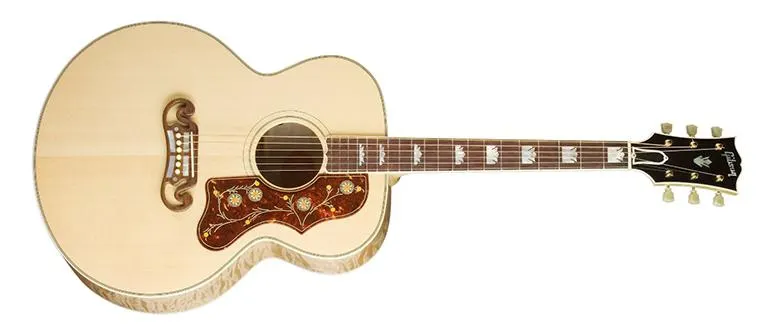
For those of you on a tighter budget, check out Epiphone guitars, which are owned by Gibson. They make finely crafted versions of Gibson’s high end guitars, but with a friendlier price tag. The value is still there, but not as damaging to the wallet.

The first three acoustic guitar body shapes we looked at are among the most widely recorded instruments. Their popularity has been defined due to their visual appeal, but also their tonal nature and the artists who have made them famous.
For those of you who want to go down the less travelled path, check out these lesser known but fully capable variants on the acoustic guitar body. Each has its own look, and because of the dimensions of the sound cavity and upper and lower bouts, they all have their own distinct feel and sound.
Dreadnought Variants with Round Shoulders
When Martin Guitars introduced the Dreadnought shape, other companies immediately followed suit. They replicated the exact body shape to get their share of the market for this highly used body shape.

Other companies, such as Gibson, even created slight variants to the Dreadnought that became extremely popular in their own right. Most notably, the Gibson J-45 surged in popularity after its introduction. It was known as a “workhorse” guitar that was affordable yet maintained all of the excellent features that came with the more costly Martin D Models.
The sunburst finish has stuck throughout the years, although you can now buy them in natural finishes. The J-45’s simple yet handsome visual appeal, alongside its affordable price made the “workhorse” name stick. The price of the instrument helped it to rise to prominence, and its warm tone that offered luscious sound that complemented any vocalist immediately created a sensation in the acoustic arena.
Now that the Gibson J-45 has become as popular among players as the Martin Dreadnought, you can expect to pay a decent premium for one, because this instrument offers a tremendous quality under the Gibson brand. I’d say the most well known Gibson J-45 player of all time has to be the one and only John Lennon of The Beatles.
Lennon even customized his instrument to include a soundboard mounted single coil pickup and volume knobs similar to some of the types of electric guitars out there.
Auditorium Guitars
Similar to the Dreadnought, but with a much more recent developmental history, stands the Auditorium body shape. Once again this is another C.F. Martin design. While it offers similar dimensions to the Dreadnought, a closer look reveals its much tighter waist, which causes certain tonal characteristics to become much more pronounced.
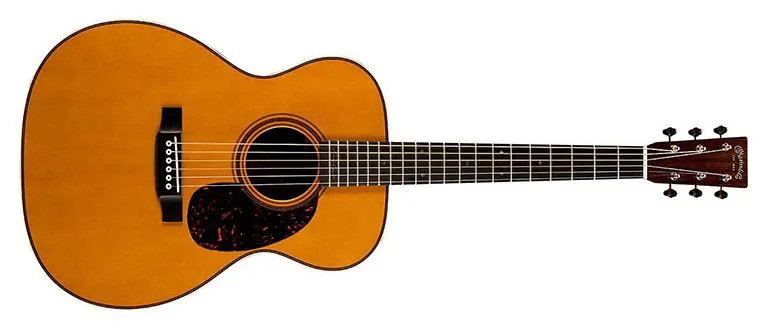
In a physical nature, the Auditorium guitar literally fits over your leg much more snug, due to its refined waist. This means that the inner curves of the guitar are defined more inward, which also decreases the amount of inner cavity the guitar shape has. This feature is more comfortable to some players who like the instrument to firmly sit on their leg without any tendency to slide around.
This tighter waist also provides certain tonal differences when compared to a Dreadnought. Whereas a Dreadnought will offer a strong Bass and Mid-Range frequency spectrum, the Auditorium tends to smooth the EQ curve to offer a balanced range with the same booming volume that the Dreadnought offers.
Some guitar aficionados claim that the Auditorium models sound great using lighter string gauges, while the Dreadnought prefers at least medium gauge strings to sound at their full potential.
I would argue that any competent guitar technician can set up an instrument to sound great regardless of string gauge, but that convention is still there, so some players still agree with this. If you play with a lighter touch, the Auditorium shape may be preferable to you.
Check out our Guitar Strings Guide if you need to know more about strings!
The most famous guitarist that uses the Auditorium shape would have to be Eric Clapton with his signature model. If you’ve ever heard his “Unplugged” album, you are already familiar with the beautiful tones that can be evoked from this style of body shape.
Clapton runs his guitar through the paces with heavy strumming, subtle finger picking, bluesy lead licks that shows the versatility that can be commanded with this shape of acoustic.
I’d recommend watching some clips of this famous concert to get a look at the sexy curves of the Auditorium guitar. They sound great and are visually appealing due to its hourglass shape.
Its best to play both types of guitar with your own hands and experience the difference yourself. If you are leaning towards the Auditorium shape, do your best to get experience handling both it and the Dreadnought, because you will feel and hear the difference compared to the very common and popular Dreadnought shape. Each player is unique and you should always choose what feels and sounds best to you!
Do note that this shape of guitar is also known as “O” guitars. They can come in ranging sizes from:
- “O”
- “OO”
- “OOO”
Each size features its own tonal emphasis, as well as volume variances. Depending on your playing style, or visual appeal, it would be worth investigating each of these variants in size.
Grand Auditorium Guitars
You probably already guessed it. The Grand Auditorium is a larger version of the smaller Auditorium style. That means it’s similar to a larger proportioned Dreadnought as well. With acoustic guitars, the larger the body shape is, the more pure unadulterated volume can be culled from it.
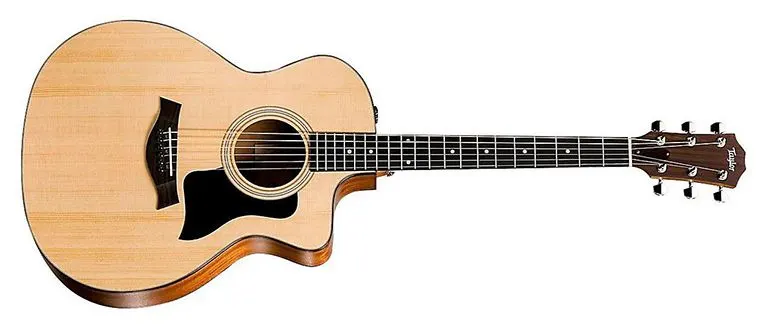
Taylor Guitars, fine purveyors of high quality acoustics, was the company to define and produce the Grand Auditorium. Due to their competitive battle for a hold in the acoustic guitar market, they have an interesting unique mixture of Martin visuals.
This includes variants on both Martin and Gibson acoustic guitar body shapes, but also include all the mainstays we have come to know and love. These instruments are also known for the high quality of “plugged in” tone.
If you want a good earful of what the Grand Auditorium guitar shape has to offer, check out the world famous Taylor Swift. During her formative years as a famous country artist, she used the Grand Auditorium almost exclusively to complement her songwriting and vocal style.
The larger shape of the guitar also complements her smaller stature, in a total reversal of how many players choose their acoustic guitar sizes.
Classical Guitars
Last, but definitely not least, is the Classical guitar. Often known for their soft Nylon string tone, they can also be strung with steel strings and have a unique sound when doing so.
Classical guitars are easily identified by their open slotted tuners, which use cams instead of standard tuner posts. The tuner knobs themselves actually recede perpendicular from the back of the headstock instead of parallel with the sides of the headstock.
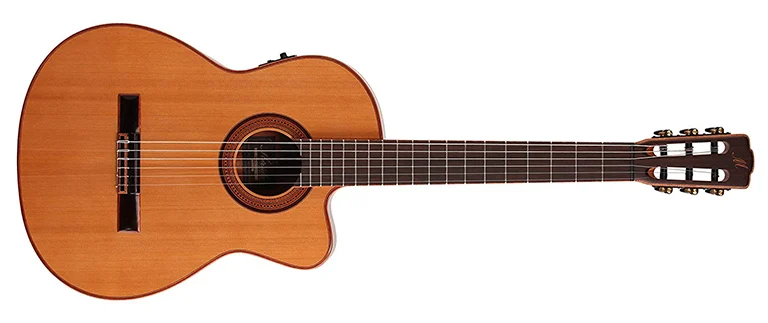
If you are a finger picker and enjoy the soft sounds of the traditional European orchestral music, the Classical guitar is definitely worth investigating. From Andres Segovia to Christopher Parkening, you’ve heard this soft tone used more than you realize, in all styles of guitar playing and music genres.
While Classical guitars with Nylon strings are often used in styles such as traditional Classical guitar and Flamenco, as previously stated, they can easily become bright strummers, like the case of the great Willie Nelson. His famous guitar has taken a beating over the years, but keeps on ticking, as a testament to the versatility of this type of Acoustic guitar.
An interesting note about Willie’s guitar, Trigger: He didn’t literally pick through the top of his guitar and remove the wood by strumming. One of his sound guys accidentally knocked his guitar off its stand during a sound check on tour, and the story goes that a microphone punched through the soundboard.
He loved the instrument so much that he just kept on playing it with no regard to the damage, and developed his unique image from that tragic stage accident.
Those are the Main Types of Acoustic Guitars
I hope that this rundown of some of the more common acoustic guitar shapes has been beneficial in your quest for the perfect axe! There are so many types and shapes of acoustic guitars that can be investigated, that any player can find the perfect match for their playing style and vocal range.
Who knows, with your newfound knowledge, you may invent a new shape that becomes your own custom commissioned signature model! Someone once revolutionized the acoustic game by introducing the concept of the acoustic electric guitar. There’s still lots of room for improvements, but everyone’s focused on playing instead of inventing!
Take your time in your quest for your perfect acoustic. There are so many variables to be considered, from visual appeal, volume, tone, size, shape, electronics or plain acoustic, and most importantly, your budget.
The best recommendation I could make is to take note of your music heroes and what choices they have made. Your perfect guitar will be inspiring and allow your art to flow from your heart, and that includes choosing the right sound as well as your preferred choice of the various guitar body styles.